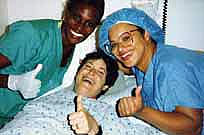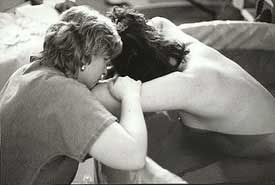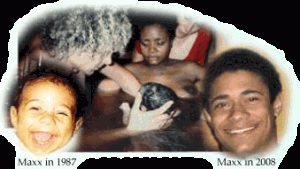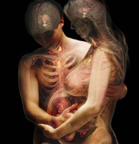By Judith Elaine Halek
Photos and Article Copyright @ 2000 Judith Elaine Halek

On February 12, 2000, Judith Elaine Halek, Director of Birth Balance and producer for a NYC cable program on underwater births, through the assistance of Japanese interpreter midwife, Yoshiko Niino, interviewed, Setsuko Yamada, a midwife of 20 years. Yamada, a calm, confident businesswoman is busier than ever despite Japan’s new plunging birthrates. Not only does she run “The Aqua Birth House,” located in the narrow back streets of Tokyo’s Setagaya Ward, she is also the owner of a coffee shop in trendy Aoyama district. Yamada comments “The cafe is a welcome change of atmosphere from my job as a midwife which can become very tense.”
Her philosophy reflected through her two books she co-edited and wrote with a medical doctor on pregnancy and birth reflect a more ‘active birth’ approach. One is written in a comic book fashion with mostly illustrations making it easier for younger mothers to read. The other book has some illustrations but is mostly text covering topics on ‘initial pregnancy and birth.’
Midwifery work in Japan has a long history. The midwife has been included in social welfare work. “Many people use to have their babies at home because they felt pregnancy was natural and they can take care of themselves quite well. But nowadays the society has changed and so do the women. The women who choose a birth center are very educated and they want to eliminate drugs or medical intervention as much as possible,” Yamada comments.
Yamada’s practiced as a registered midwife in Japan first in a hospital, then as a teacher  in a nursing school and continued until she got sick and decided to become an independent midwife.
in a nursing school and continued until she got sick and decided to become an independent midwife.
Why Yamada became a midwife was not from a deep concept. When she had worked with the ‘American system of childbirth’ in the hospital where many of the women had anesthesia she realized, if she was pregnant, she wouldn’t want to have a baby that way. Along with those feelings and her belief about ‘childbirth naturally’ she became more interested in assisting the birth from the beginnings of life.
Almost 2 years as an intern at another birth center, after consulting with her CPA, Yamada decided to set up her own practice in 1995 under the original name, “The Birth House.” In late 1998, Yamada bought property, moved to a roomier location, opened “The Aquatic Birth House” and resides there as well with her husband.
Since 1995 Yamada has attended almost 400 births including the home births and half of these were waterbirths.
She believes the fact that one is 37 doesn’t mean anything if they are healthy and haven’t had any serious illnesses. “These women can birth naturally,” Yamada comments. Three of Yamada’s clients gave birth naturally after having a C-section at a hospital the previous time. “There were no problems,” she added.
There are no doctors or nurses, epidurals, episiotomies, or separate rooms for the newborns at her Aqua Birth House. Instead one is greeted with a waterfall, African carvings of a mother and her child, fresh flowers and a table of birth icons. There are sensitive and beautiful photos of natural birth throughout the House and slippers for everyone provided at the front door.
 The labor and birth area, downstairs, contains an aqua blue oval tub, covered with a sterile plastic cover, weighted down by sterling sliver dolphin, moon and starburst clips, keeping the tub clean and available to use at any time. The tub is next to a cluttered desk, a bed that rotates up and down, colorful bean bags to sit or lean on, a short low birth chair, a geriatric stool to lean over with a hidden foam pad which Yamada quickly retrieves from under the bed. With a press of a button a heat a toilet is seated. With a press of a few more buttons a genital area is washed and dried automatically. Ah, the wonders of another country. Yamada believes in low light levels and keeps the overhead lights off and the decorative side wall lights on. Midwives utilize an underwater doppler stethoscope to check the babies heart tones. The house includes steep staircases, a modest kitchen, an additional room with a jacuzzi tub, areas for weighing, bathing and checking the jaundice levels of the babies.
The labor and birth area, downstairs, contains an aqua blue oval tub, covered with a sterile plastic cover, weighted down by sterling sliver dolphin, moon and starburst clips, keeping the tub clean and available to use at any time. The tub is next to a cluttered desk, a bed that rotates up and down, colorful bean bags to sit or lean on, a short low birth chair, a geriatric stool to lean over with a hidden foam pad which Yamada quickly retrieves from under the bed. With a press of a button a heat a toilet is seated. With a press of a few more buttons a genital area is washed and dried automatically. Ah, the wonders of another country. Yamada believes in low light levels and keeps the overhead lights off and the decorative side wall lights on. Midwives utilize an underwater doppler stethoscope to check the babies heart tones. The house includes steep staircases, a modest kitchen, an additional room with a jacuzzi tub, areas for weighing, bathing and checking the jaundice levels of the babies.
There is an antiquated ultrasound machine available if Yamada needs to check the position of the baby. She rarely uses this machine and never charges extra if she does. (Tell that to an American hospital!)
Yamada proudly displays how the ‘regular bed’ not ‘delivery bed’ in the room with the tub has a vibrating massage feature as well as the head reset and the end of the bed rotate up and down. Between the bean chairs, birthing stool, kneeling on the floor, “many positions for the mother,” becomes one of Yamada’s trademark
During the summer, an option in the House for women who want to labor longer in a pool, is the smaller jacuzzi tub in an adjoining room. As a result of longer periods of time in this pool, some women and babies are content to birth here instead of the main tub. During the winter, this room is not available because it doesn’t have the appropriate heating. Yamada’s plans for next year to redesign and install a heater in the space will make this room available year round.
In another area of the cozy Aqua Birth House is a small bathtub set on a ledge near the sink for bathing the baby. There is an external heater on to keep the temperature safe for the baby.
It is the practice of the Birth Center to incorporate the father as the main person to practice washing the baby in the bath before they leave the House. Yamada teaches only the father how to bathe the baby, not the mother. This is a way to establish a special commitment from the father in his assistance and caregiving for the child. The bath is not given the first day of the birth, only the second day after. Every day Yamada checks the babies jaundice with a small, handheld portable machine.
washing the baby in the bath before they leave the House. Yamada teaches only the father how to bathe the baby, not the mother. This is a way to establish a special commitment from the father in his assistance and caregiving for the child. The bath is not given the first day of the birth, only the second day after. Every day Yamada checks the babies jaundice with a small, handheld portable machine.
Under the sink where the water source is, there are two different colored tubes. Yamada explains, “One of the most important aspects of a waterbirth is that the water should be very clean.” Therefore she has one tube indicating, clean water in and the other, contaminated water out. She also has a water pump she only utilizes after the mother and baby is out of the tub.
There is also a rather primitive tabletop scale to weigh the baby. Yamada comments, ” This is a scale for the baby. All babies get their mother’s milk and don’t have to be checked after each feeding. It is important to check the weight when the baby is first born.”
We ascend the narrow winding stairs to the postpartum rooms. There are three adjoining rooms with soji sliding screens made of a blonde wood and simulated rice paper. In actuality the paper is the farthest thing from fragile, light rice paper. It is a plaster fibrous material that is actually quite strong to the touch. Futons on the floor with brightly colored linen create a cozy haven to nest in after the arduous miracle of birth. Yamada states, “Some women have their babies in this bed, but not many. Always after the baby is born he/she stays with the mother and the father can stay here too. So the parents and babies sleep together in this bed.”
Yamada continues, “The purpose of placing the rooms so close together was planned. It is our belief when a baby cries and the other people can hear this, they can join in on learning to raise a baby in ‘a family way’ where crying is normal. Sometimes other babies will cry when one baby cries.” There is also a rather large hole in the handle of the sliding door. “The purpose in the planning of this,” Yamada demonstrates “is to keep open to everybody what is going on. For example, those inside the room need to see what is going on outside and those outsides the room can see in so they don’t feel a necessity to go in and interrupt so often. A closed door, not know what’s going on inside or outside needed to be eliminated. This is the way we do that.”
 Yamada’s assistant and midwife in training, Ms. Megumi Tanaki was seven months pregnant when I did the interview. Tanaki’s background as a nurse for many years in a private hospital and University Medical Hospital left her feeling limited as a nurse. Tanaki shares, “When I worked as a shift nurse and the Hospital became bigger and bigger, I wasn’t able to manage what I wanted to do as a nurse because it is institutionalized and I had to work as a group organization.”
Yamada’s assistant and midwife in training, Ms. Megumi Tanaki was seven months pregnant when I did the interview. Tanaki’s background as a nurse for many years in a private hospital and University Medical Hospital left her feeling limited as a nurse. Tanaki shares, “When I worked as a shift nurse and the Hospital became bigger and bigger, I wasn’t able to manage what I wanted to do as a nurse because it is institutionalized and I had to work as a group organization.”
Tanaki continues, “In the older days, midwives were called ‘sambas.’ They could ork even if they became aged. I felt it was a worthy position, so by the age 30 after I graduate school, I decided I wanted to work with midwife, Yamada.”
Tanaki’s greatest happiness comes from assisting the births. “I don’t have any conflict with what I am doing. I have been married for 6 years but my period was not so regular. Since I have worked with Yamada and the parents and babies, my physical balance is quite good. I believe my hormones become more balanced when I assist the births with the mothers and babies. I work in good circumstances so this is my happiness,” concludes Tanaki.
babies, my physical balance is quite good. I believe my hormones become more balanced when I assist the births with the mothers and babies. I work in good circumstances so this is my happiness,” concludes Tanaki.
Judith Elaine Halek is the Founder and Director of Birth Balance, the East Coast resource center for underwater birth, which she began in 1987. One of the original labor support doulas in New York City, she has pioneered alternative choices in childbirth throughout the tri-state area. A birth consultant and counselor, massage and fitness therapist, writer, educator, speaker, photographer, videographer and producer of Birth Balance Presents: Water Birth, a Manhattan Educational Cable Station, Judith is airing her third thirteen-part weekly series on underwater birth and midwifery related issues.
If you would like to contact Judith directly by email she’s at: Judith@BirthBalance.com.
Her contact numbers are: 212-222-4349 (phone/fax) and mailing address: Judith Halek, Birth Balance, 309 W. 109th St., Suite 6D, NYC, NY 10025.
There is a beautiful Photo Documentary by Shin. Sawano, narrator Chara, Music Naoko Etoh, produced by TELEMAC video and CD format available entitled, “Born To Be Loved,” Yamada is featured assisting water births, as well as other professionals and parents labor and birthing in more traditional settings. To purchase a copy of the video or CD, contact: www.LEMITON.com and click on Family Ties. If you would like to contact the Yamada you may write to: The Aqua Birth House, Midwife Setsuko Yamada, 4-16–21 Sakuragaoka, Setagaya Ku, Tokyo, 156-0054, JAPAN. Phone: 03-3427-1314, Fax: 03-3427-1314.

 1. October 2, 1993 at 12:22 a.m., an 8 pound 14 ounce beautiful baby girl, Ariella Renee Garmaise-Schlossberg, her parents Judy and Boris, medical caregiver, Dr. Juanita Jenyons marked the first successful water birth at Roosevelt Hospital.
1. October 2, 1993 at 12:22 a.m., an 8 pound 14 ounce beautiful baby girl, Ariella Renee Garmaise-Schlossberg, her parents Judy and Boris, medical caregiver, Dr. Juanita Jenyons marked the first successful water birth at Roosevelt Hospital. history presented itself in the first United States, documented hospital frank breech underwater birth. The courageous parents of newborn, Damon, are Stacie Teele and Dan Varrichione. Dr. Gae Rodkey was the medical caregiver.
history presented itself in the first United States, documented hospital frank breech underwater birth. The courageous parents of newborn, Damon, are Stacie Teele and Dan Varrichione. Dr. Gae Rodkey was the medical caregiver. 4. Come July 7, 1994, Janis Enzenbacher MD, chose water as a labor and birth tool for the underwater birthing of her daughter Eva Liana, entering the world at 11:11 pm with Dr. Rodkey as the attending physician and Isadora Guggenheim as the attending Labor Support Doula and Massage Therapist.
4. Come July 7, 1994, Janis Enzenbacher MD, chose water as a labor and birth tool for the underwater birthing of her daughter Eva Liana, entering the world at 11:11 pm with Dr. Rodkey as the attending physician and Isadora Guggenheim as the attending Labor Support Doula and Massage Therapist. ward in Roosevelt Hospital. The OB ward no longer allows parents to bring in their portable tubs. The birth center has 3 rooms with 3 tubs to labor, but not to birth in. It is my hope that eventually the birth center will open its doors to the water birth option as well.
ward in Roosevelt Hospital. The OB ward no longer allows parents to bring in their portable tubs. The birth center has 3 rooms with 3 tubs to labor, but not to birth in. It is my hope that eventually the birth center will open its doors to the water birth option as well.

 in a nursing school and continued until she got sick and decided to become an independent midwife.
in a nursing school and continued until she got sick and decided to become an independent midwife. The labor and birth area, downstairs, contains an aqua blue oval tub, covered with a sterile plastic cover, weighted down by sterling sliver dolphin, moon and starburst clips, keeping the tub clean and available to use at any time. The tub is next to a cluttered desk, a bed that rotates up and down, colorful bean bags to sit or lean on, a short low birth chair, a geriatric stool to lean over with a hidden foam pad which Yamada quickly retrieves from under the bed. With a press of a button a heat a toilet is seated. With a press of a few more buttons a genital area is washed and dried automatically. Ah, the wonders of another country. Yamada believes in low light levels and keeps the overhead lights off and the decorative side wall lights on. Midwives utilize an underwater doppler stethoscope to check the babies heart tones. The house includes steep staircases, a modest kitchen, an additional room with a jacuzzi tub, areas for weighing, bathing and checking the jaundice levels of the babies.
The labor and birth area, downstairs, contains an aqua blue oval tub, covered with a sterile plastic cover, weighted down by sterling sliver dolphin, moon and starburst clips, keeping the tub clean and available to use at any time. The tub is next to a cluttered desk, a bed that rotates up and down, colorful bean bags to sit or lean on, a short low birth chair, a geriatric stool to lean over with a hidden foam pad which Yamada quickly retrieves from under the bed. With a press of a button a heat a toilet is seated. With a press of a few more buttons a genital area is washed and dried automatically. Ah, the wonders of another country. Yamada believes in low light levels and keeps the overhead lights off and the decorative side wall lights on. Midwives utilize an underwater doppler stethoscope to check the babies heart tones. The house includes steep staircases, a modest kitchen, an additional room with a jacuzzi tub, areas for weighing, bathing and checking the jaundice levels of the babies. washing the baby in the bath before they leave the House. Yamada teaches only the father how to bathe the baby, not the mother. This is a way to establish a special commitment from the father in his assistance and caregiving for the child. The bath is not given the first day of the birth, only the second day after. Every day Yamada checks the babies jaundice with a small, handheld portable machine.
washing the baby in the bath before they leave the House. Yamada teaches only the father how to bathe the baby, not the mother. This is a way to establish a special commitment from the father in his assistance and caregiving for the child. The bath is not given the first day of the birth, only the second day after. Every day Yamada checks the babies jaundice with a small, handheld portable machine. Yamada’s assistant and midwife in training, Ms. Megumi Tanaki was seven months pregnant when I did the interview. Tanaki’s background as a nurse for many years in a private hospital and University Medical Hospital left her feeling limited as a nurse. Tanaki shares, “When I worked as a shift nurse and the Hospital became bigger and bigger, I wasn’t able to manage what I wanted to do as a nurse because it is institutionalized and I had to work as a group organization.”
Yamada’s assistant and midwife in training, Ms. Megumi Tanaki was seven months pregnant when I did the interview. Tanaki’s background as a nurse for many years in a private hospital and University Medical Hospital left her feeling limited as a nurse. Tanaki shares, “When I worked as a shift nurse and the Hospital became bigger and bigger, I wasn’t able to manage what I wanted to do as a nurse because it is institutionalized and I had to work as a group organization.” babies, my physical balance is quite good. I believe my hormones become more balanced when I assist the births with the mothers and babies. I work in good circumstances so this is my happiness,” concludes Tanaki.
babies, my physical balance is quite good. I believe my hormones become more balanced when I assist the births with the mothers and babies. I work in good circumstances so this is my happiness,” concludes Tanaki.



